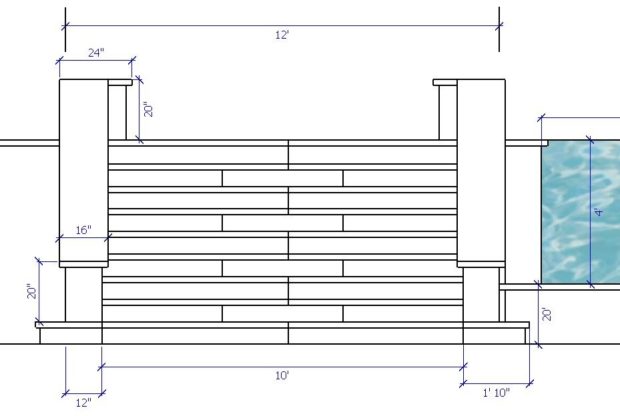 Once the pool construction detailed in my last post was in a reasonably finished state, a substantial amount of stonework would be required to finish terracing this steeply sloping yard. The drop from the pool terrace to the lower terrace is about 5.5 feet, meaning stairs would be necessary to access the lower level. A pair of 10′ wide stone staircases flanking the pool would permit easy access and flow from the upper to the lower terrace. Mike Newman, stone contractor extraordinnaire, and owner of Mountain Paver Construction Co, sent numerous drawings of these stairs to me over a period of a few weeks, until every detail was worked out.
Once the pool construction detailed in my last post was in a reasonably finished state, a substantial amount of stonework would be required to finish terracing this steeply sloping yard. The drop from the pool terrace to the lower terrace is about 5.5 feet, meaning stairs would be necessary to access the lower level. A pair of 10′ wide stone staircases flanking the pool would permit easy access and flow from the upper to the lower terrace. Mike Newman, stone contractor extraordinnaire, and owner of Mountain Paver Construction Co, sent numerous drawings of these stairs to me over a period of a few weeks, until every detail was worked out.
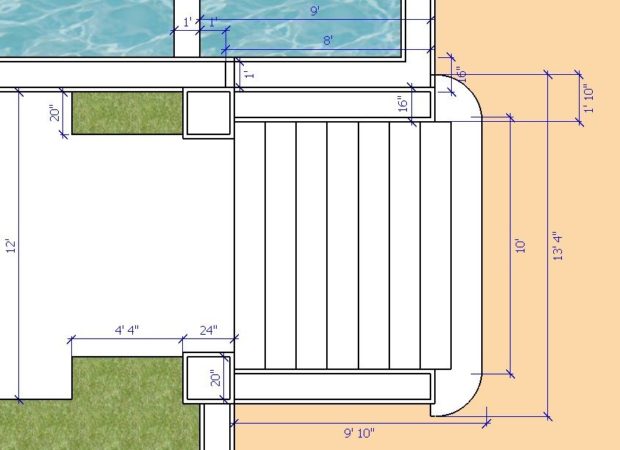 Though the plan I had drawn was to scale, it was necessary to produce specialized drawings of these stairs. The pool was a given whose dimensions could not be changed. Everything to come would have to be adjusted to meet those “as built” dimensions. Producing a precise drawing can help mitigate problems later. He would have to order stone cut to specific dimensions. Surprises can be great, but not so much for a stone structure that would take months to build. My drawings of the stairs were place holders, and nothing more. The stairs would be built from his drawings.
Though the plan I had drawn was to scale, it was necessary to produce specialized drawings of these stairs. The pool was a given whose dimensions could not be changed. Everything to come would have to be adjusted to meet those “as built” dimensions. Producing a precise drawing can help mitigate problems later. He would have to order stone cut to specific dimensions. Surprises can be great, but not so much for a stone structure that would take months to build. My drawings of the stairs were place holders, and nothing more. The stairs would be built from his drawings.
 Mike and I did research and send for a number of stone samples. Pictured above is what was eventually presented to my clients for the wall stone veneer, the pool deck and stairs stone, and the bluestone dots. Veneer stone is available in many different color mixes. It was eventually decided to use 25% of one mix, and 75% of another. Once stone is chosen, it takes time to get an order processed and shipped. The stone for the pool deck was special ordered in 2′ square pieces that are 2 1/4″ thick The pool deck stone was mortared to a concrete substrate. The stone for the stairs was custom cut for this particular project.
Mike and I did research and send for a number of stone samples. Pictured above is what was eventually presented to my clients for the wall stone veneer, the pool deck and stairs stone, and the bluestone dots. Veneer stone is available in many different color mixes. It was eventually decided to use 25% of one mix, and 75% of another. Once stone is chosen, it takes time to get an order processed and shipped. The stone for the pool deck was special ordered in 2′ square pieces that are 2 1/4″ thick The pool deck stone was mortared to a concrete substrate. The stone for the stairs was custom cut for this particular project. To follow are pictures that detail the work on the walls and stairs that took the better part of 7 months to complete.
To follow are pictures that detail the work on the walls and stairs that took the better part of 7 months to complete. 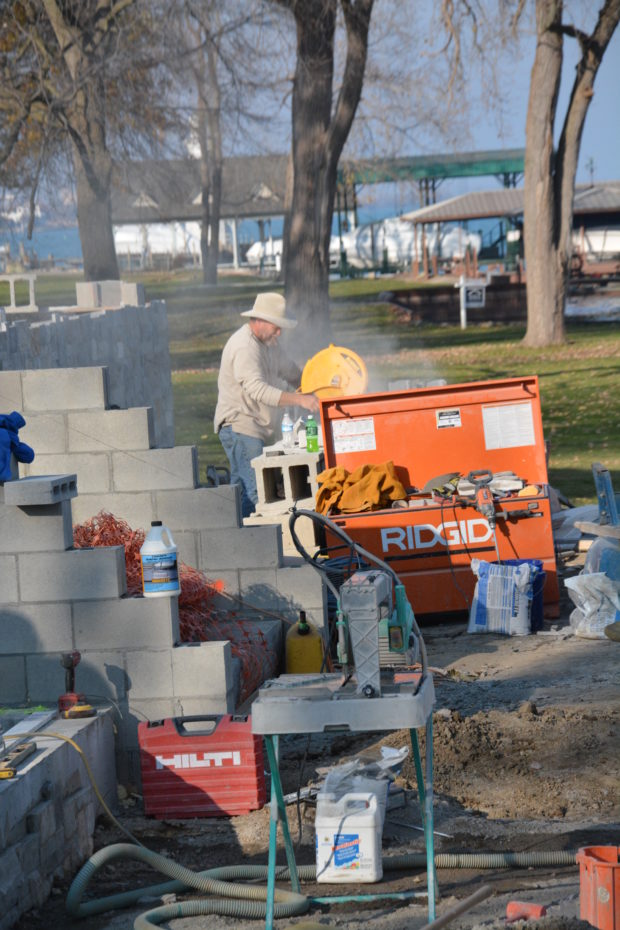 Every piece of stone that went on the wall had to be cut so they would fit together smoothly without any mortar joints. This was an aesthetic decision, not a construction decision. My clients liked the look without.
Every piece of stone that went on the wall had to be cut so they would fit together smoothly without any mortar joints. This was an aesthetic decision, not a construction decision. My clients liked the look without.
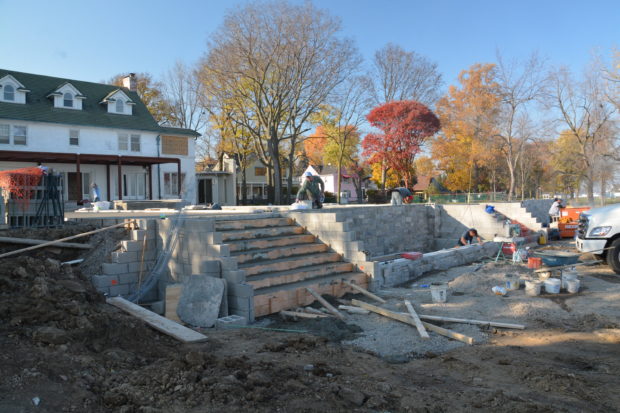 The concrete for the north and south staircases were poured adjacent to the lower pool. All foundations and stonework that was part of the pool and the lower pool were done by the pool contractor.
The concrete for the north and south staircases were poured adjacent to the lower pool. All foundations and stonework that was part of the pool and the lower pool were done by the pool contractor.
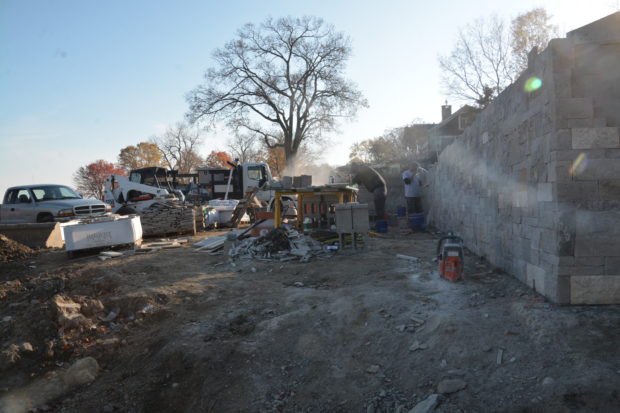 I had hopes of beginning the rear yard landscape last fall, but that was not to be. The trucks and equipment necessary to complete the stone work occupied a a lot of the back yard space. An earth ramp had to be built so equipment and vehicles could be driven to the rear yard. Building anything is a big messy business. All of those vehicles and pallets of stone made me wince-the compaction of the soil would be an issue we would have to deal with later.
I had hopes of beginning the rear yard landscape last fall, but that was not to be. The trucks and equipment necessary to complete the stone work occupied a a lot of the back yard space. An earth ramp had to be built so equipment and vehicles could be driven to the rear yard. Building anything is a big messy business. All of those vehicles and pallets of stone made me wince-the compaction of the soil would be an issue we would have to deal with later.
 The dark stones you see in the wall above are from the second mix. That darker color would add some interest to these big walls. A table full of stone enabled Mike to pick and choose the shapes and colors as he saw fit.
The dark stones you see in the wall above are from the second mix. That darker color would add some interest to these big walls. A table full of stone enabled Mike to pick and choose the shapes and colors as he saw fit.
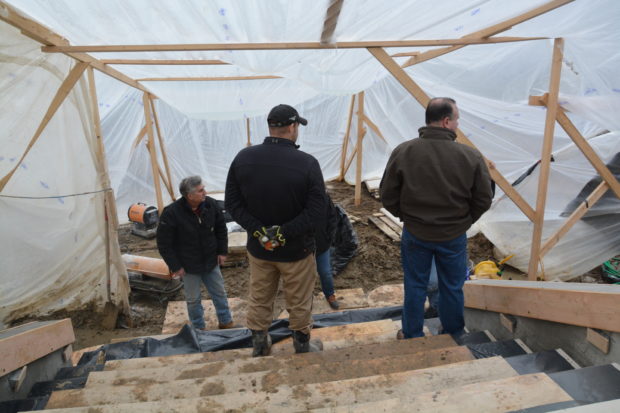 Eventually it became necessary to tent and heat the area around the construction of the final staircase and retaining wall, so the work could continue. Continue it did, all winter long.
Eventually it became necessary to tent and heat the area around the construction of the final staircase and retaining wall, so the work could continue. Continue it did, all winter long.

veneer stone being applied to wall
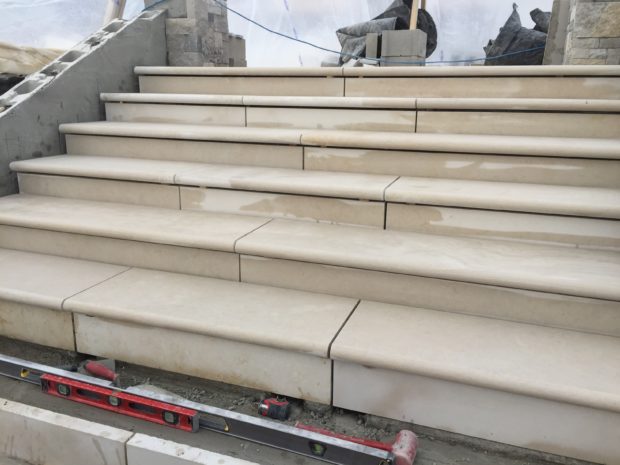 valders stone treads and risers in place
valders stone treads and risers in place
 The return on the final and bottom step of the staircase was a complex shape, so Mike built a template so I could see what it would look like. Sometimes a drawing is not enough information. That piece of stone would be radiused and bull nosed at the stone yard.
The return on the final and bottom step of the staircase was a complex shape, so Mike built a template so I could see what it would look like. Sometimes a drawing is not enough information. That piece of stone would be radiused and bull nosed at the stone yard.
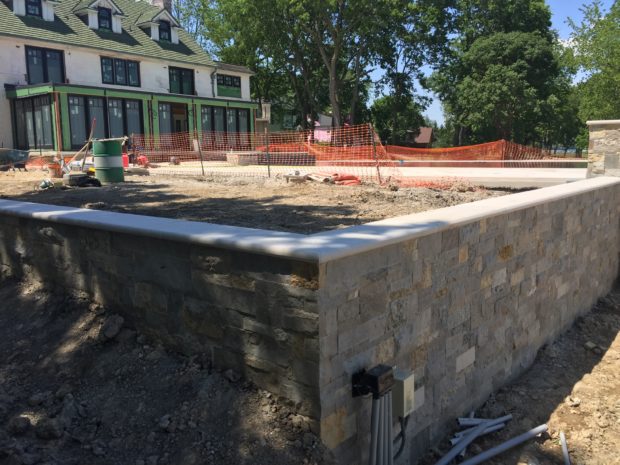 By spring, the south retaining wall was done.
By spring, the south retaining wall was done.
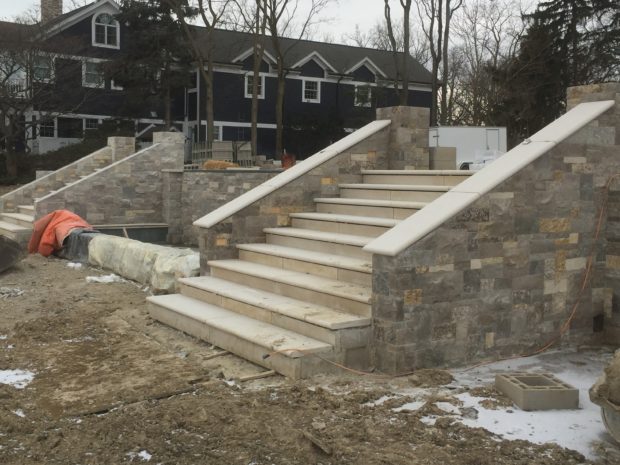 staircase done but for the curved lower step returns
staircase done but for the curved lower step returns
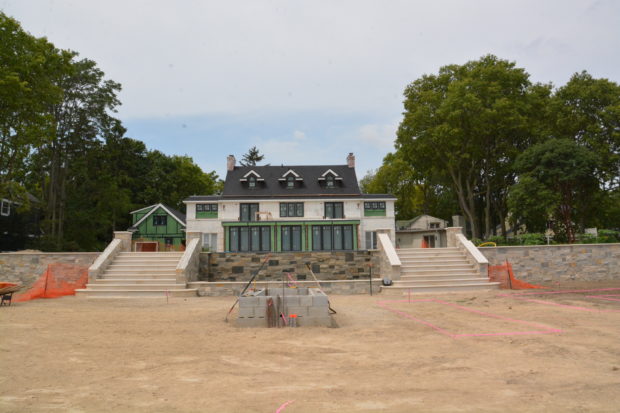 Just a few weeks ago, we were finally able to begin laying out the landscape for the lower level. The concrete block structure in the middle foreground is a firepit under construction. Once that foundation and block work was done, it was time for some green. My superintendent Dan thinks a good bit of this lower level landscape will be finished in a few days. Needless to say, I have pictures.
Just a few weeks ago, we were finally able to begin laying out the landscape for the lower level. The concrete block structure in the middle foreground is a firepit under construction. Once that foundation and block work was done, it was time for some green. My superintendent Dan thinks a good bit of this lower level landscape will be finished in a few days. Needless to say, I have pictures.

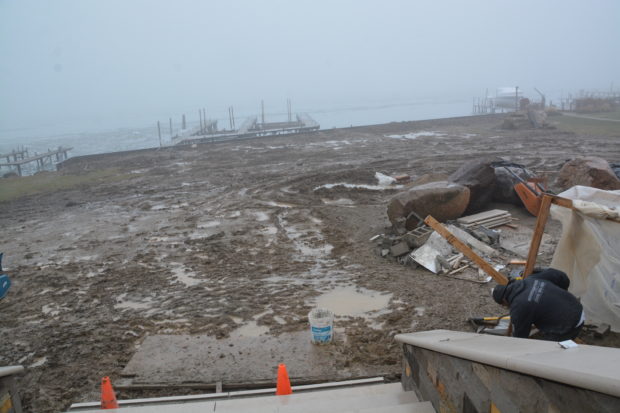

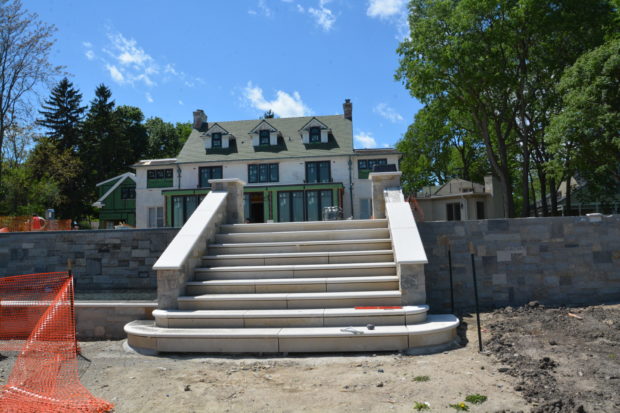
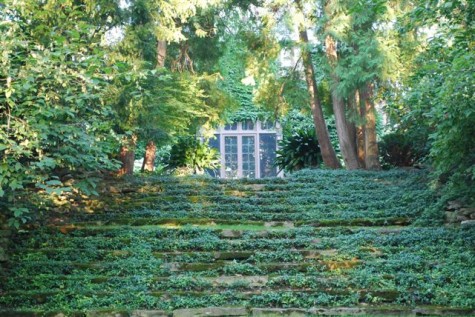 This very old, very lovely, wide flight of stairs was once buried in soil and debris; only the center four feet was still visible and useable. I discovered it by accident, while trying to plant trees and groundcover on either side. Once I explained to my client that another twelve feet of staircase still existed just below the surface, she had me uncover it entirely. We planted the risers with myrtle. This staircase is much more about ornament and architecture, than about going from one level to another. As the lower garden is viewed primarily from the house above, the beauty of these steps is more important than the issue of how to get from here to there.
This very old, very lovely, wide flight of stairs was once buried in soil and debris; only the center four feet was still visible and useable. I discovered it by accident, while trying to plant trees and groundcover on either side. Once I explained to my client that another twelve feet of staircase still existed just below the surface, she had me uncover it entirely. We planted the risers with myrtle. This staircase is much more about ornament and architecture, than about going from one level to another. As the lower garden is viewed primarily from the house above, the beauty of these steps is more important than the issue of how to get from here to there.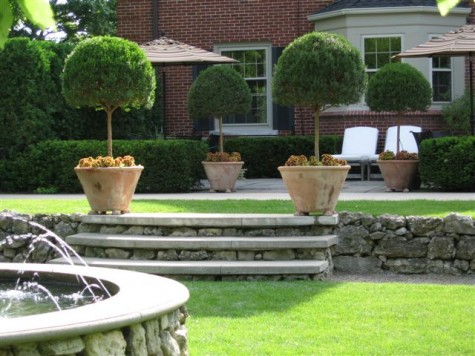 The change of level in a landscape can create interest, announce a new garden room-change things up. This previously sloped garden space was excavated and walled with the stone that had been used to edge the original beds. The steps now necessary to descend to the lower level signal the transition. The treads are shallow, so as not to intrude on the rectangle of grass below. A good height for a step is 7 inches; 8 inches will work, but is just slightly on the steep side. Every step in a flight of stairs needs to be the same height; people instinctively assume this. Note how the gravel in front of the wall, dying into the lower step, makes the maintenance of the lawn plane simple.
The change of level in a landscape can create interest, announce a new garden room-change things up. This previously sloped garden space was excavated and walled with the stone that had been used to edge the original beds. The steps now necessary to descend to the lower level signal the transition. The treads are shallow, so as not to intrude on the rectangle of grass below. A good height for a step is 7 inches; 8 inches will work, but is just slightly on the steep side. Every step in a flight of stairs needs to be the same height; people instinctively assume this. Note how the gravel in front of the wall, dying into the lower step, makes the maintenance of the lawn plane simple.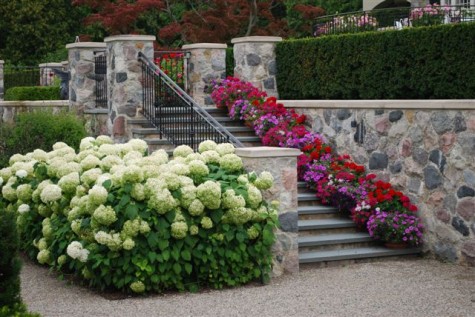 Some changes of level are dramatic, and require a flight of steps, and railings. Any stairs need to be designed first and foremost to allow for safe passage. Each of these steps is marked with its own pot of flowers. The iron railing is as sturdy as it is beautiful. Iron rails allow a garden to remain open to view while providing some security.
Some changes of level are dramatic, and require a flight of steps, and railings. Any stairs need to be designed first and foremost to allow for safe passage. Each of these steps is marked with its own pot of flowers. The iron railing is as sturdy as it is beautiful. Iron rails allow a garden to remain open to view while providing some security. Splitting up steps can be even more friendly to guests. It is far easier to negotiate one or two steps at a time, with a landing in place prior to the next set of steps. These stairs are wider that the door and side windows; this makes for a generous and welcoming approach.
Splitting up steps can be even more friendly to guests. It is far easier to negotiate one or two steps at a time, with a landing in place prior to the next set of steps. These stairs are wider that the door and side windows; this makes for a generous and welcoming approach. This winding staircase seems to spill out of the confluence of two walls designed and built on the bias. The variation in stair width creates a sense of motion and rhythm which is very pleasing. The wall enclosure makes it possible to climb these stairs with confidence.
This winding staircase seems to spill out of the confluence of two walls designed and built on the bias. The variation in stair width creates a sense of motion and rhythm which is very pleasing. The wall enclosure makes it possible to climb these stairs with confidence.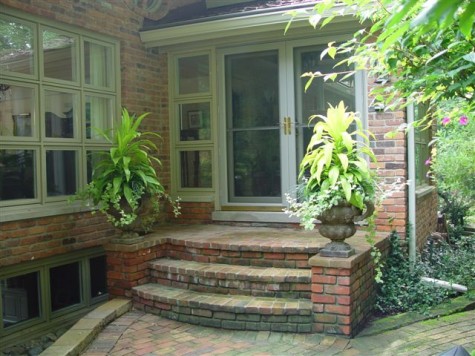 Stairs can vary in their depth. The first stair out of this front door functions as a landing-a comfortable space for greetings, and goodbys. The brick piers and pots are a succesful alternative to railings, which would have seemed so heavy handed here.
Stairs can vary in their depth. The first stair out of this front door functions as a landing-a comfortable space for greetings, and goodbys. The brick piers and pots are a succesful alternative to railings, which would have seemed so heavy handed here. Natural stone frequently has a uneven surface. Planning for a safe ascent and descent is doubly important. The iron fence walls inset from the stairs provide an emergency handhold for anyone loosing their footing.
Natural stone frequently has a uneven surface. Planning for a safe ascent and descent is doubly important. The iron fence walls inset from the stairs provide an emergency handhold for anyone loosing their footing. 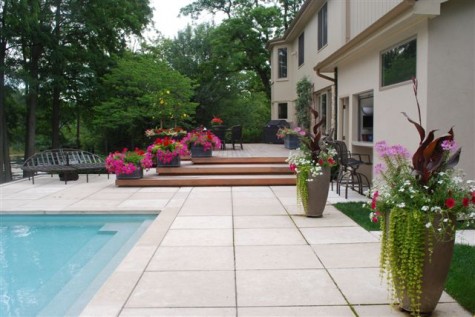 These wood stairs to the upper terrace are very spacious in every dimension. Steps with greater depth are easier to negotiate. Steps to a rear terrace are frequently used while carrying food and drink; it is better to err on the side of too deep, than too shallow. The pots announce the change of level for anyone concentrating more on keeping their tray of food where it belongs, , than watching where they step.
These wood stairs to the upper terrace are very spacious in every dimension. Steps with greater depth are easier to negotiate. Steps to a rear terrace are frequently used while carrying food and drink; it is better to err on the side of too deep, than too shallow. The pots announce the change of level for anyone concentrating more on keeping their tray of food where it belongs, , than watching where they step.